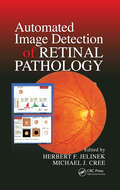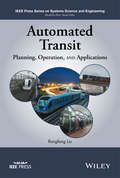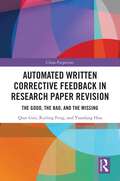- Table View
- List View
Automated Guided Vehicle Systems: A Primer with Practical Applications
by Günter UllrichThis primer is directed at experts and practitioners in intralogistics who are concerned with optimizing material flows. The presentation is comprehensive covering both, practical and theoretical aspects with a moderate degree of specialization, using clear and concise language. Areas of operation as well as technical standards of all relevant components and functions are described. Recent developments in technology and in the markets are taken into account. The goal of this book is to further stronger use of automated guided transport systems and the enhancement of their future performance.
Automated Guided Vehicle Systems: A Guide - With Practical Applications - About The Technology - For Planning
by Günter Ullrich Thomas AlbrechtThis professional book provides a comprehensive overview of the modern organisational tool of intralogistics. Automated Guided Vehicle Systems (AGV Systems) are floor-based systems that are used internally inside and/or outside of buildings. Since the mid-1990s, AGV Systems have successfully penetrated almost all sectors of industry and many public areas, such as hospitals. The technological standards of all AGV-relevant components and functions are explained and numerous practical examples, e.g. from the automotive, electrical and food industries, are presented. Another focus is the practical planning of such intralogistics systems based on the VDI guidelines, including hints and tips for successful project management when introducing an AGV System. This edition has been completely revised, restructured and reflects the rapid developments in technology and markets.
Automated Hierarchical Synthesis of Radio-Frequency Integrated Circuits and Systems: A Systematic and Multilevel Approach
by Fábio Passos Elisenda Roca Rafael Castro-López Francisco V. FernándezThis book describes a new design methodology that allows optimization-based synthesis of RF systems in a hierarchical multilevel approach, in which the system is designed in a bottom-up fashion, from the device level up to the (sub)system level. At each level of the design hierarchy, the authors discuss methods that increase the design robustness and increase the accuracy and efficiency of the simulations. The methodology described enables circuit sizing and layout in a complete and automated integrated manner, achieving optimized designs in significantly less time than with traditional approaches.
Automated Highway Systems
by Petros IoannouExperts address some of the main issues and uncertainties associated with the design and deployment of Automated Highway Systems (AHS). They discuss new AHS concepts, technology, and benefits, as well as institutional, environmental, and social issues - concerns that will affect dramatically the operation of the current highway system from both the vehicle and infrastructure points of view.
Automated Image Detection of Retinal Pathology
by Herbert Jelinek Michael J. CreeDiscusses the Effect of Automated Assessment Programs on Health Care ProvisionDiabetes is approaching pandemic numbers, and as an associated complication, diabetic retinopathy is also on the rise. Much about the computer-based diagnosis of this intricate illness has been discovered and proven effective in research labs. But, unfortunately, many of
Automated Inspection and Quality Assurance
by Stanley L. Robinson Richard Kendall MillerNew concepts for gaging, inspection, checking, machine vision, and robotic testing. Includes guidelines for installing complex electronic and computerized systems and a directory of commercially availalbe computer software, as well as distributors' names and addresses. Annotation copyright Book News
Automated Inspection and Quality Assurance (Quality And Reliability Ser. #16)
by Stanley L. Robinson Richard Kendall MillerNew concepts for gaging, inspection, checking, machine vision, and robotic testing. Includes guidelines for installing complex electronic and computerized systems and a directory of commercially availalbe computer software, as well as distributors' names and addresses. Annotation copyright Book News
Automated Low-Altitude Air Delivery: Towards Autonomous Cargo Transportation with Drones (Research Topics in Aerospace)
by Johann C. DauerThis book investigates Unmanned Aircraft Systems (UAS) with a payload capacity of one metric ton for transportation. The authors provide a large variety of perspectives–from economics to technical realization. With the focus on such heavy-lift cargo UAS, the authors consider recently established methods for approval and certification, which they expect to be disruptive for unmanned aviation. In particular, the Specific Operations Risk Assessment (SORA) and its impact on the presented technological solutions and operational concepts are studied. Starting with the assumption of an operation over sparsely populated areas and below common air traffic, diverse measures to further reduce operational risks are proposed. Operational concepts derived from logistics use-cases set the context for an in-depth analysis including aircraft and system design, safe autonomy as well as airspace integration and datalinks. Results from simulations and technology demonstrations are presented as a proof of concept for solutions proposed in this book.
Automated Methods in Cryptographic Fault Analysis
by Jakub Breier Xiaolu Hou Shivam BhasinThis book presents a collection of automated methods that are useful for different aspects of fault analysis in cryptography. The first part focuses on automated analysis of symmetric cipher design specifications, software implementations, and hardware circuits. The second part provides automated deployment of countermeasures. The third part provides automated evaluation of countermeasures against fault attacks. Finally, the fourth part focuses on automating fault attack experiments. The presented methods enable software developers, circuit designers, and cryptographers to test and harden their products.
Automated Nanohandling by Microrobots (Springer Series in Advanced Manufacturing)
by Sergej FatikowThis book provides an introduction to robot-based nanohandling. It presents work on the development of a versatile microrobot-based nanohandling robot station inside a scanning electron microscope (SEM). Those unfamiliar with the subject will find the text, which is complemented throughout by the extensive use of illustrations, clear and simple to understand. The author has published two books and numerous papers in the field, and holds more than 50 patents.
Automated Pattern Analysis in Petroleum Exploration
by Sailes K. Sengupta IbrahimPalazHere is a state-of-the-art survey of artificial intelligence in modern exploration programs. Focussing on standard exploration procedures, the contributions examine the advantages and pitfalls of using these new techniques, and, in the process, provide new, more accurate and consistent methods for solving old problems. They show how expert systems can provide the integration of information that is essential in the petroleum industry when solving the complicated questions facing the modern petroleum geoscientist.
Automated Scheduling and Planning: From Theory to Practice (Studies in Computational Intelligence #505)
by A. Sima Uyar Ender Ozcan Neil UrquhartSolving scheduling problems has long presented a challenge for computer scientists and operations researchers. The field continues to expand as researchers and practitioners examine ever more challenging problems and develop automated methods capable of solving them. This book provides 11 case studies in automated scheduling, submitted by leading researchers from across the world. Each case study examines a challenging real-world problem by analysing the problem in detail before investigating how the problem may be solved using state of the art techniques.The areas covered include aircraft scheduling, microprocessor instruction scheduling, sports fixture scheduling, exam scheduling, personnel scheduling and production scheduling. Problem solving methodologies covered include exact as well as (meta)heuristic approaches, such as local search techniques, linear programming, genetic algorithms and ant colony optimisation.The field of automated scheduling has the potential to impact many aspects of our lives and work; this book highlights contributions to the field by world class researchers.
Automated Software Engineering: A Deep Learning-Based Approach (Learning and Analytics in Intelligent Systems #8)
by Suresh Chandra Satapathy Ajay Kumar Jena Jagannath Singh Saurabh BilgaiyanThis book discusses various open issues in software engineering, such as the efficiency of automated testing techniques, predictions for cost estimation, data processing, and automatic code generation. Many traditional techniques are available for addressing these problems. But, with the rapid changes in software development, they often prove to be outdated or incapable of handling the software’s complexity. Hence, many previously used methods are proving insufficient to solve the problems now arising in software development. The book highlights a number of unique problems and effective solutions that reflect the state-of-the-art in software engineering. Deep learning is the latest computing technique, and is now gaining popularity in various fields of software engineering. This book explores new trends and experiments that have yielded promising solutions to current challenges in software engineering. As such, it offers a valuable reference guide for a broad audience including systems analysts, software engineers, researchers, graduate students and professors engaged in teaching software engineering.
Automated Software Testing: Foundations, Applications and Challenges (Services and Business Process Reengineering)
by Ajay Kumar Jena Himansu Das Durga Prasad MohapatraThis book covers both theory and applications in the automation of software testing tools and techniques for various types of software (e.g. object-oriented, aspect-oriented, and web-based software). When software fails, it is most often due to lack of proper and thorough testing, an aspect that is even more acute for object-oriented, aspect-oriented, and web-based software. Further, since it is more difficult to test distributed and service-oriented architecture-based applications, there is a pressing need to discuss the latest developments in automated software testing. This book discusses the most relevant issues, models, tools, challenges, and applications in automated software testing. Further, it brings together academic researchers, scientists, and engineers from a wide range of industrial application areas, who present their latest findings and identify future challenges in this fledging research area.
Automated Solution of Differential Equations by the Finite Element Method: The FEniCS Book (Lecture Notes in Computational Science and Engineering #84)
by Anders Logg Kent-Andre Mardal Garth WellsThis book is a tutorial written by researchers and developers behind the FEniCS Project and explores an advanced, expressive approach to the development of mathematical software. The presentation spans mathematical background, software design and the use of FEniCS in applications. Theoretical aspects are complemented with computer code which is available as free/open source software. The book begins with a special introductory tutorial for beginners. Following are chapters in Part I addressing fundamental aspects of the approach to automating the creation of finite element solvers. Chapters in Part II address the design and implementation of the FEnicS software. Chapters in Part III present the application of FEniCS to a wide range of applications, including fluid flow, solid mechanics, electromagnetics and geophysics.
Automated Transit: Planning, Operation, and Applications (IEEE Press Series on Systems Science and Engineering)
by Rongfang LiuA comprehensive discussion of automated transit This book analyzes the successful implementations of automated transit in various international locations, such as Paris, Toronto, London, and Kuala Lumpur, and investigates the apparent lack of automated transit applications in the urban environment in the United States. The book begins with a brief definition of automated transit and its historical development. After a thorough description of the technical specifications, the author highlights a few applications from each sub-group of the automated transit spectrum. International case studies display various technologies and their applications, and identify vital factors that affect each system and performance evaluations of existing applications. The book then discusses the planning and operation of automated transit applications at both macro and micro levels. Finally, the book covers a number of less successful concepts, as well as the lessons learned, allowing readers to gain a comprehensive understanding of the topic. Key features: Provides a thorough examination of automated transit applications, their impact and implications for society Written by the committee chair for the Automated Transit Systems Transportation, Research Board Offers essential information on planning, costs, and applications of automated transit systems Covers driverless metros, automated LRT, group and personal rapid transit, a review of worldwide applications Includes capacity and safety guidelines, as well as vehicles, propulsion, and communication and control systems This book is essential reading for engineers, researchers, scientists, college or graduate students who work in transportation planning, engineering, operation and management fields.
Automated Transit: Planning, Operation, and Applications (IEEE Press Series on Systems Science and Engineering)
by Rongfang LiuA comprehensive discussion of automated transit This book analyzes the successful implementations of automated transit in various international locations, such as Paris, Toronto, London, and Kuala Lumpur, and investigates the apparent lack of automated transit applications in the urban environment in the United States. The book begins with a brief definition of automated transit and its historical development. After a thorough description of the technical specifications, the author highlights a few applications from each sub-group of the automated transit spectrum. International case studies display various technologies and their applications, and identify vital factors that affect each system and performance evaluations of existing applications. The book then discusses the planning and operation of automated transit applications at both macro and micro levels. Finally, the book covers a number of less successful concepts, as well as the lessons learned, allowing readers to gain a comprehensive understanding of the topic. Key features: Provides a thorough examination of automated transit applications, their impact and implications for society Written by the committee chair for the Automated Transit Systems Transportation, Research Board Offers essential information on planning, costs, and applications of automated transit systems Covers driverless metros, automated LRT, group and personal rapid transit, a review of worldwide applications Includes capacity and safety guidelines, as well as vehicles, propulsion, and communication and control systems This book is essential reading for engineers, researchers, scientists, college or graduate students who work in transportation planning, engineering, operation and management fields.
Automated Validation & Verification of UML/OCL Models Using Satisfiability Solvers
by Nils Przigoda Robert Wille Judith Przigoda Rolf DrechslerThis book provides a comprehensive discussion of UML/OCL methods and design flow, for automatic validation and verification of hardware and software systems. While the presented flow focuses on using satisfiability solvers, the authors also describe how these methods can be used for any other automatic reasoning engine. Additionally, the design flow described is applied to a broad variety of validation and verification tasks. The authors also cover briefly how non-functional properties such as timing constraints can be handled with the described flow.
Automated Vehicles as a Game Changer for Sustainable Mobility: Learnings and Solutions (Contributions to Management Science)
by Danielle Attias Adrian Boos Dimitri Konstantas Guy FournierThis open access book explores a vision for a sustainable future in urban mobility through the AVENUE project, showcasing full-scale demonstrations of automated minibuses in European cities. AVENUE pioneers on-demand, door-to-door services, challenging traditional fixed bus itineraries. It delves into the implementation of automated vehicles, emphasizing safety, services, cybersecurity, and accessibility. Part two evaluates the economic, environmental, and social impacts on companies, citizens, and cities. By integrating automated vehicles into Mobility-as-a-Service and Intelligent Transport Systems, the book argues for the using of automated vehicles as game changer towards a transformative shift to sustainable, citizen-centric mobility. It advocates for efficiency, flexibility, and resilience of the transport system without imposing coercive transformation policies.
Automated Written Corrective Feedback in Research Paper Revision: The Good, The Bad, and The Missing (China Perspectives)
by Qian Guo Ruiling Feng Yuanfang HuaThis book studies the use of an automated writing evaluation (AWE) systems in research paper revision for publication purposes by Chinese doctoral students.Research writing skills are essential for achieving academic status, and AWE tools can be a great companion on the journey. However, AWE tools may provide a disservice if users do not stay alert to inaccurate feedback, inaccurate correction suggestions, and missed errors. The effects of accurate feedback on revision outcomes have been the focus of a number of AWE studies, but student engagement and revision results in cases of inaccurate feedback and missed errors have rarely been investigated. Such investigations can provide practical advice on using automated feedback in research writing. This book provides a comprehensive evaluation of AWE tools and profiles student engagement with tool use in cases of different qualities of feedback. It can empower novice scholars and improve the effectiveness of academic writing instructors. The findings can also inform AWE system developers about possible ways of system improvement for research paper writing.The book will be particularly useful to students and scholars of language and linguistic studies, education, and academic English writing.
Automated Written Corrective Feedback in Research Paper Revision: The Good, The Bad, and The Missing (China Perspectives)
by Qian Guo Ruiling Feng Yuanfang HuaThis book studies the use of an automated writing evaluation (AWE) systems in research paper revision for publication purposes by Chinese doctoral students.Research writing skills are essential for achieving academic status, and AWE tools can be a great companion on the journey. However, AWE tools may provide a disservice if users do not stay alert to inaccurate feedback, inaccurate correction suggestions, and missed errors. The effects of accurate feedback on revision outcomes have been the focus of a number of AWE studies, but student engagement and revision results in cases of inaccurate feedback and missed errors have rarely been investigated. Such investigations can provide practical advice on using automated feedback in research writing. This book provides a comprehensive evaluation of AWE tools and profiles student engagement with tool use in cases of different qualities of feedback. It can empower novice scholars and improve the effectiveness of academic writing instructors. The findings can also inform AWE system developers about possible ways of system improvement for research paper writing.The book will be particularly useful to students and scholars of language and linguistic studies, education, and academic English writing.
Automaten: Die konstruktive Durchbildung die Werkzeuge, die Arbeitsweise und der Betrieb der selbsttätigen Drehbänke Ein Lehr- und Nachschlagebuch
by Ph. KelleDieser Buchtitel ist Teil des Digitalisierungsprojekts Springer Book Archives mit Publikationen, die seit den Anfängen des Verlags von 1842 erschienen sind. Der Verlag stellt mit diesem Archiv Quellen für die historische wie auch die disziplingeschichtliche Forschung zur Verfügung, die jeweils im historischen Kontext betrachtet werden müssen. Dieser Titel erschien in der Zeit vor 1945 und wird daher in seiner zeittypischen politisch-ideologischen Ausrichtung vom Verlag nicht beworben.
Automaten: Die konstruktive Durchbildung die Werkzeuge, die Arbeitsweise und der Betrieb der selbsttätigen Drehbänke. Ein Lehr- und Nachschlagebuch
by Philipp KelleDieser Buchtitel ist Teil des Digitalisierungsprojekts Springer Book Archives mit Publikationen, die seit den Anfängen des Verlags von 1842 erschienen sind. Der Verlag stellt mit diesem Archiv Quellen für die historische wie auch die disziplingeschichtliche Forschung zur Verfügung, die jeweils im historischen Kontext betrachtet werden müssen. Dieser Titel erschien in der Zeit vor 1945 und wird daher in seiner zeittypischen politisch-ideologischen Ausrichtung vom Verlag nicht beworben.





















